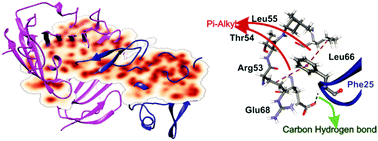The urokinase plasminogen activator binding to its receptor: a quantum biochemistry description within an in/homogeneous dielectric function framework with application to uPA–uPAR peptide inhibitors
Abstract
Despite being recognized as a therapeutic target in the processes of cancer cell proliferation and metastasis for over 50 years, the interaction of the urokinase plasminogen activator uPA with its receptor uPAR still needs an improved understanding. High resolution crystallographic data (PDB 2FD6) of the uPA–uPAR binding geometry was used to perform quantum biochemistry computations within the density functional theory (DFT) framework. A divide to conquer methodology considering a mixed homogeneous/inhomogeneous dielectric model and explicitly taking water molecules into account was employed to obtain a large set of uPA–uPAR residue–residue interaction energies. In order of importance, not only were Phe25 > Tyr24 > Trp30 > Ile28 shown to be the most relevant uPA residues binding it to uPAR, but the residues Lys98 > His87 > Gln40 > Asn22 > Lys23 > Val20 also had significant interaction energies, which helps to explain published experimental mutational data. Furthermore, the results obtained with the uPA–uPAR in/homogeneous dielectric function show that a high dielectric constant value ε = 40 is adequate to take into account the electrostatic environment at the interface between the proteins, while using a smaller value of ε (<10) leads to an overestimation of the uPA–uPAR binding energy. Hot spots of the uPA–uPAR binding domain were identified and a quantum biochemistry description of the uPAR blockers uPA21–30 and cyclo21,29uPA21–29[(S21C;H29C)] was performed, demonstrating that cyclization improves the stability of mimetic peptides without compromising their binding energies to uPAR.



 Please wait while we load your content...
Please wait while we load your content...